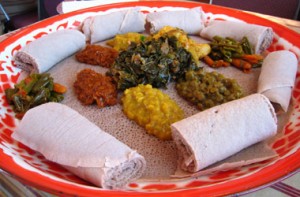Tadias Magazine
By Dr. Asqual Getaneh
Saturday, November 26, 2011
New York (TADIAS) – Whether or not it is made from toasted or raw beans, cooked thick or thin, spiced up or buttered, shiro along with other legumes is perhaps the most nourishing, ubiquitous and affordable dish in Ethiopia. Unfortunately, shiro appears less frequently on dinner tables as a result of economic and social success. The trend is an irrational and en masse adoption of Western commercial diets (along with culture and politics); yet, the same diets are the main culprits for the growing health problem in the U.S. and Europe. We grab on fistfuls of processed foods in beautifully designed packets in lieu of our traditional diet. In this, we, Ethiopians, are not alone. Very few traditions have successfully resisted the marketing lure and the temptation of colorfully wrapped easy-to-cook and ready-to-eat meals. It does not help, that no one celebrates with shiro and that it is used to express pity or religious compunction. As a result, shiro recedes even further from our esteem and creative culinary imaginations.
Against this tide, we would like to argue that shiro and other legumes should be celebrated victuals in Ethiopian households (and non-Ethiopian households) for the following reasons. First, shiro is a healthy source of both macro-and micro-nutrients. Depending on regional preferences, a typical shiro dish is made from one of three legumes, broad (fava) beans, chick peas (garbanzo) or round peas, or as in the current trend, from flour mixture of all three beans. Although there are some differences in nutrient content, each of these legumes is a low fat source of protein, carbohydrate, fiber, iron and folate, among numerous other vitamins and minerals.
For those of you worried about getting adequate protein from beans, according to the USDA the average woman and man require 46 grams and 51 grams of protein per day respectively. However, for elite athletes the daily requirement is as high as 1.37 grams per kilograms of body weight per day. A cup of shiro provides about 16.3 grams of protein. Compare this with 20 grams of protein in a serving of chicken breast, 19 grams in salmon and 22 grams in beef steak.
Second, shiro is usually served with tomato salad and vegetables such as collard greens (gomen), cabbage, or string beans and carrot (fasolia), dishes that are rich in vitamin A and C. In addition gomen and cabbage have vitamin K and folate and are filled with phytochemicals including diindolymethane, and sulforaphane — antioxidants that boost the body’s cancer fighting potential. Carrots and tomatoes have carotenoids and tomatoes contain lycopene — a specific type of carotenoid that has a strong antioxidant property. When mixed with berbere, shiro provides additional vitamin A.
Shiro as many other Ethiopian dishes is never eaten without injera, preferably injera made of teff -a super grain that rivals quinoa in its proportional protein and superior calcium and iron content. In sufficient quantities, Teff also provides a third of the daily requirement for riboflavin, niacin, vitamin B6, folate and other micronutrients. Those of us living in the United States and outside of the Washington DC area, are not lucky enough to easily obtain teff-based injera and have to resort to various other combinations that are not as nutritious and that can be more calorie dense than teff-based injera. So, when consuming non-teff based injera, it is prudent to assess calorie and carbohydrate content, especially if one is concerned about obesity, metabolic diseases or have diabetes.
Third, “shiro yum!”. Ok, we may be shooting for the stars trying to sell creamy delicious shiro to kurt-loving readers and during the holiday season. But get into your meditative zone and consider all the possible flavors in shiro like coriander, cardamom, garlic, and berbere; also visualize other bean dishes like buticha, yeshimbra asa and ful. And, if only for an interesting addition to your bean dish cornucopia, foray into the unique land of hilbet, boquilt, siljo, or gulban. I guarantee if not your taste buds your body will be tingling happily. To err is human, so if you are not convinced enough to have shiro and other legumes frequently, we hope that this will at least engage your culinary imagination to include shiro in some form in your diet.
In sum, shiro is a great source of protein; and when combined with vegetables and tomato salad shiro-based meals provide almost all of the average daily requirements of folate, vitamin A, C and K. Include the goodness of teff and the meal will have additional micronutrients such as iron, calcium and vitamin B6. For individuals concerned about carbohydrates, injera made of teff has low glycemia load by virtue of its proportional fiber and protein content (estimated glycemia load of 84 for a cup of uncooked teff, compare this to 104 for a cup of uncooked rice). Add the antioxidant properties of carotenoids and phytochemicals, and shiro and its accompaniments are now in the realm of food-as-medicine. Above all shiro tastes heavenly. At a minimum, we should curb our flight into the dizzying glitter of substitute foods, even as many in the West reverse their course through the growing slow, organic, farm-to-table and locovore food movements.
—
Related:
Our Beef with Kitfo: Are Ethiopians in America Subscribing to the Super Sizing of Food?


Thank you Dr Getaneh,
Shiro is probably the best Ethiopian food there is, but most folks look down on it and prefer raw kitfo.
I love shiro!!
Dr. Asqual, thank you for explaining the benefits of shiro. For some ignorant reason we are programed to think that shiro is only for poor people. Maybe that explains why the rich are unhealthy 🙂
i love shiro!
There is no question this report is right on. What we have as Ethiopians is nothing short of Golden. We just don’t know it. Unfortunately the world has been a victim of western marketing phsycoholgy. We were raised to look westward from childhood, beginning learning how to sign our names in English to wearing belbottms as youngsters and now eating salads as sign of health conciousness. Just be Ethiopian and you will be cool, because Ethiopian is cool.
A lot of Ethios know Teff has iron. They don’t know Teff is full of the described wonderful substances, iron, calcium, protien, vitamines. Eating Teff is like taking your multi-vitamines.
Muzlitach,
Hold your horses there buddy. You forgot tire siga (the real version of kitfo). That can’t be too cool. That’s scary to little kids. 🙂 for real tho
Gomen Ras
Did the Simpsons try Shiro during their visit to Little Ethiopia the other day? I thought that was cool. Gursha, gursha gursha!!!!
I also like the sound of Doke when its done rigt!!..dok dok dok…!!!
I am always asked by people who know Ethiopians,why most probably all Ethiopians are thin healthy looking with spider fingers?.What do you eat?.Whether I am wrong or not I tell them,we eat always cooked food not fried foods and in most households two days every week(WEN & Fri) we are off limit from Diary & Meat product.Thanks.
Dr. Asqual Getaneh:
First of all, thank you for a great article! And happy holidays to you! I have one injera health related question. Do you know of any scientific reasons why it is so difficult to make gluten-free injera in US? Gluten-free injera means 100% teff, nothing else can’t be mixed with it. Ten percent of the American population requires gluten-free diet for health reasons. But here, in most places, they give you all sorts of excuses why it can’t be made and the reasons range from the water is different here than in Ethiopia to the teff grown in Kansas is different than the one from Ethiopia (I would I agree with that). But, is there a way to make 100% gluten free injera?
Thank you.
M.
Shiro is yummy!
Hello there,
Just wanted to say thanks for featuring my picture of shiro! It is one of my favorite foods, such a comforting meal on a cold Fall or Winter night.
Aletcha shiro is my favourite.
Add basil and green onion in Shiro, amazingly tasty.
Aletcha shero [can] be used as a gravy for a Thanksgiving turkey. Really good.
shero leni my freand my brother &my mother i never live with out shiro.
SHIRO ! any time. Glorious healthy food.